A Preliminary Study for Isometric, Isotonic, and Isokinetic Relationships in Vertical Drop Jumps at Heights on the Beam †
Abstract
1. Introduction
2. Literature Review
3. Methodology
3.1. Subjects
3.2. Validation System and Video Calibration in Kinovea Software
3.3. Experimental Set-Up
3.4. Experimental Protocols
3.5. Motion Tracking Using Kinovea
3.6. Angle Measurement
3.7. Statistical Analysis
4. Result and Discussion
5. Conclusions
Author Contributions
Funding
Institutional Review Board Statement
Informed Consent Statement
Data Availability Statement
Acknowledgments
Conflicts of Interest
References
- Kim, M.-K.; Yoo, K.-T. Effect of isotonic and isokinetic exercise on muscle activity and balance of the ankle joint. J. Phys. Ther. Sci. 2015, 27, 415–420. [Google Scholar] [CrossRef] [PubMed]
- Van Driessche, S.; Van Roie, E.; Vanwanseele, B.; Delecluse, C. Test-retest reliability of knee extensor rate of velocity and power development in older adults using the isotonic mode on a Biodex System 3 dynamometer. PLoS ONE 2018, 13, e0196838. [Google Scholar] [CrossRef]
- Nambi, G.; Abdelbasset, W.K.; Alrawaili, S.M.; Alsubaie, S.F.; Abodonya, A.M.; Saleh, A.K. Virtual reality or isokinetic training; its effect on pain, kinesiophobia, and serum stress hormones in chronic low back pain: A randomized controlled trial. Technol. Health Care 2021, 29, 155–166. [Google Scholar] [CrossRef]
- Lum, D.; Barbosa, T.M. Brief review: Effects of isometric strength training on strength and dynamic performance. Int. J. Sports Med. 2019, 40, 363–375. [Google Scholar] [CrossRef] [PubMed]
- Kodesh, E.; Shargal, E.; Kislev-Cohen, R.; Funk, S.; Dorfman, L.; Samuelly, G.; Hoffman, J.R.; Sharvit, N. Examination of the Effectiveness of Predictors for Musculoskeletal Injuries in Female Soldiers. J. Sports Sci. Med. 2015, 14, 515–521. [Google Scholar] [PubMed]
- Peng, H.-T.; Khuat, C.; Kernozek, T.; Wallace, B.; Lo, S.-L.; Song, C.-Y. Optimum Drop Jump Height in Division III Athletes: Under 75% of Vertical Jump Height. Int. J. Sports Med. 2017, 38, 842–846. [Google Scholar] [CrossRef]
- Qiu, J.; Kang, J. Exercise Associated Muscle Cramps—A Current Perspective. Sci. Pages Sports Med. 2017, 1, 3–14. [Google Scholar]
- Yu, H.-B.; Li, J.; Zhang, R.; Hao, W.-H.; Lin, J.-Z.; Tai, W.-H. Effects of Jump-Rope-Specific Footwear Selection on Lower Extremity Biomechanics. Bioengineering 2022, 9, 135. [Google Scholar] [CrossRef]
- Borzì, F.; Szychlinska, M.; Di Rosa, M.; Musumeci, G. A Short Overview of the Effects of Kinesio Taping for Postural Spine Curvature Disorders. J. Funct. Morphol. Kinesiol. 2018, 3, 59. [Google Scholar] [CrossRef]
- Shishov, N.; Elabd, K.; Komisar, V.; Chong, H.; Robinovitch, S.N. Accuracy of Kinovea software in estimating body segment movements during falls captured on standard video: Effects of fall direction, camera perspective, and video calibration technique. PLoS ONE 2021, 16, e0258923. [Google Scholar] [CrossRef]
- Harrington, M.; Adeyinka, I.; Burkhart, T.A. Intrarater and Interrater Reliability and Agreement of a Method to Quantify Lower-Extremity Kinematics Using Remote Data Collection. J. Sport Rehabil. 2023, 32, 1–9. [Google Scholar] [CrossRef] [PubMed]
- Carleton, R.N.; Korol, S.; Mason, J.E.; Hozempa, K.; Anderson, G.S.; Jones, N.A.; Dobson, K.S.; Szeto, A.; Bailey, S. A longitudinal assessment of the road to mental readiness training among municipal police. Cogn. Behav. Ther. 2018, 47, 508–528. [Google Scholar] [CrossRef] [PubMed]
- Merrigan, J.J.; Stone, J.D.; Thompson, A.G.; Hornsby, W.G.; Hagen, J.A. Monitoring Neuromuscular Performance in Military Personnel. Int. J. Environ. Res. Public Health 2020, 17, 9147. [Google Scholar] [CrossRef]
- Admin. Latihan Perorangan Dasar Halang Rintang Prajurit Petarung “Candraca” Yonif 4 Marinir. Available online: https://tni.mil.id/view-194045-latihan-perorangan-dasar-halang-rintang-prajurit-petarung-candraca-yonif-4-marinir.html (accessed on 22 June 2024).
- Putri, M. Lari Halang Rintang: Pengertian Dan Tekniknya. Available online: https://www.kompas.com/skola/read/2022/11/29/140000669/lari-halang-rintang--pengertian-dan-tekniknya#google_vignette (accessed on 22 June 2024).
- Pelopor Wiratama. Yonbekpal 2 Marinir Latih Kekompakan Tim Dengan Halang Rintang. Available online: https://peloporwiratama.co.id/2023/05/19/yonbekpal-2-marinir-latih-kekompakan-tim-dengan-halang-rintang/ (accessed on 22 June 2024).
- English, T.; Howe, K. The Effect of Pilates Exercise on Trunk and Postural Stability and Throwing Velocity in College Baseball Pitchers: Single Subject Design. N. Am. J. Sports Phys. Ther. 2007, 2, 8–21. [Google Scholar] [PubMed]
- Kim, M.-K.; Choi, J.-H.; Gim, M.-A.; Kim, Y.-H.; Yoo, K.-T. Effects of different types of exercise on muscle activity and balance control. J. Phys. Ther. Sci. 2015, 27, 1875–1881. [Google Scholar] [CrossRef]
- Lee, K.; Lee, Y.W. Efficacy of ankle control balance training on postural balance and gait ability in community-dwelling older adults: A single-blinded, randomized clinical trial. J. Phys. Ther. Sci. 2017, 29, 1590–1595. [Google Scholar] [CrossRef]
- Morasso, P. Integrating ankle and hip strategies for the stabilization of upright standing: An intermittent control model. Front. Comput. Neurosci. 2022, 16, 956932. [Google Scholar] [CrossRef] [PubMed]
- Nyland, J.; Franklin, T.; Short, A.; Calik, M.; Kaya, D. Posture, Kinesthesia, Foot Sensation, Balance, and Proprioception. Proprioception in Orthopaedics. In Proprioception in Orthopaedics, Sports Medicine and Rehabilitation; Kaya, D., Yosmaoglu, B., Doral, M., Eds.; Springer: Cham, Switzerland, 2017; pp. 13–24. [Google Scholar] [CrossRef]
- Lin, C.-F.; Chen, C.-Y.; Lin, C.-W. Dynamic Ankle Control in Athletes with Ankle Instability During Sports Maneuvers. Am. J. Sports Med. 2011, 39, 2007–2015. [Google Scholar] [CrossRef]
- Loram, I.D.; Lakie, M. Human balancing of an inverted pendulum: Position control by small, ballistic-like, throw and catch movements. J. Physiol. 2002, 540, 1111–1124. [Google Scholar] [CrossRef]
- Feher, J. Skeletal Muscle Mechanics. In Quantitative Human Physiology: An Introduction, 2nd ed.; Academic Press: Salt Lake City, UT, USA, 2012; pp. 239–248. [Google Scholar] [CrossRef]
- Seiberl, W.; Power, G.A.; Herzog, W.; Hahn, D. The stretch-shortening cycle (SSC) revisited: Residual force enhancement contributes to increased performance during fast SSCs of human m. adductor pollicis. Physiol. Rep. 2015, 3, e12401. [Google Scholar] [CrossRef]
- Durall, C.J.; Sawhney, R. Strength. In Therapeutic Exercise: Treatment Planning for Progression; Huber, F.E., Wells, C.L., Eds.; Saunders Elsevier: Hokoben, NJ, USA, 2006; pp. 96–125. [Google Scholar] [CrossRef]
- Carr, J.H.; Shepherd, R.B. Chapter 7: Strength training and physical conditioning. In Stroke Rehabilitation Guidelines for Exercise and Training to Optimize Motor Skill; Elsevier Health Sciences: London, UK, 2003; pp. 233–258. [Google Scholar] [CrossRef]
- Knapik, J.J.; Wright, J.E.; Mawdsley, R.H.; Braun, J. Isometric, Isotonic, and Isokinetic Torque Variations in Four Muscle Groups Through a Range of Joint Motion. Phys. Ther. 1983, 63, 938–947. [Google Scholar] [CrossRef]
- Lee, S.E.K.; de Lira, C.A.B.; Nouailhetas, V.L.A.; Vancini, R.L.; Andrade, M.S. Do isometric, isotonic and/or isokinetic strength trainings produce different strength outcomes? J. Bodyw. Mov. Ther. 2018, 22, 430–437. [Google Scholar] [CrossRef]
- Hughes, D.C.; Ellefsen, S.; Baar, K. Adaptations to Endurance and Strength Training. Cold Spring Harb. Perspect. Med. 2018, 8, 1–17. [Google Scholar] [CrossRef] [PubMed]
- Naz, I.; Sahin, H.; Uçsular, F.D.; Yalnız, E. A comparison trial of eight weeks versus twelve weeks of exercise program in interstitial lung diseases. Sarcoidosis Vasc. Diffus. Lung Dis. 2018, 35, 299–307. [Google Scholar] [CrossRef]
- Schops, T.; Schonberger, J.L.; Galliani, S.; Sattler, T.; Schindler, K.; Pollefeys, M.; Geiger, A. A Multi-view Stereo Benchmark with High-Resolution Images and Multi-camera Videos. In Proceedings of the IEEE Conference on Computer Vision and Pattern Recognition (CVPR), Honolulu, HI, USA, 21–26 July 2017; pp. 3260–3269. [Google Scholar] [CrossRef]
- Kuller, R.; Laike, T. The impact of flicker from fluorescent lighting on well-being, performance, and physiological arousal. Ergonomics 1998, 41, 433–447. [Google Scholar] [CrossRef] [PubMed]
- Koo, S.; Andriacchi, T.P. The Knee Joint Center of Rotation is Predominantly on the Lateral Side during Normal Walking. J. Biomech. 2008, 41, 1269–1273. [Google Scholar] [CrossRef]
- Bujang, K.; Ahmad Nazri, A.F.; Ahmad Azam, A.F.; Mahmud, J. Developing a motion capture system using Kinect. J. Teknol. 2015, 76, 75–86. [Google Scholar] [CrossRef]
- Fuglsang, E.I.; Telling, A.S.; Sørensen, H. Effect of Ankle Mobility and Segment Ratios on Trunk Lean in the Barbell Back Squat. J. Strength Cond. Res. 2017, 31, 3024–3033. [Google Scholar] [CrossRef]
- Krosshaug, T.; Slauterbeck, J.R.; Engebretsen, L.; Bahr, R. Biomechanical analysis of anterior cruciate ligament injury mechanisms: Three-dimensional motion reconstruction from video sequences. Scand. J. Med. Sci. Sports 2007, 17, 508–519. [Google Scholar] [CrossRef]
- Elrahim, R.M.A.; Embaby, E.A.; Ali, M.F.; Kamel, R.M. Inter-rater and intra-rater reliability of Kinovea software for measurement of shoulder range of motion. Bull. Fac. Phys. Ther. 2016, 21, 80–87. [Google Scholar] [CrossRef]
- Ab Patar, M.N.A.; Komeda, T.; Cheng Yee, L.; Mahmud, J. Model-based systems engineering of a hand rehabilitation device. J. Teknol. 2015, 76, 101–106. [Google Scholar] [CrossRef][Green Version]
- List, R.; Gülay, T.; Stoop, M.; Lorenzetti, S. Kinematics of the Trunk and the Lower Extremities During Restricted and Unrestricted Squats. J. Strength Cond. Res. 2013, 27, 1529–1538. [Google Scholar] [CrossRef] [PubMed]
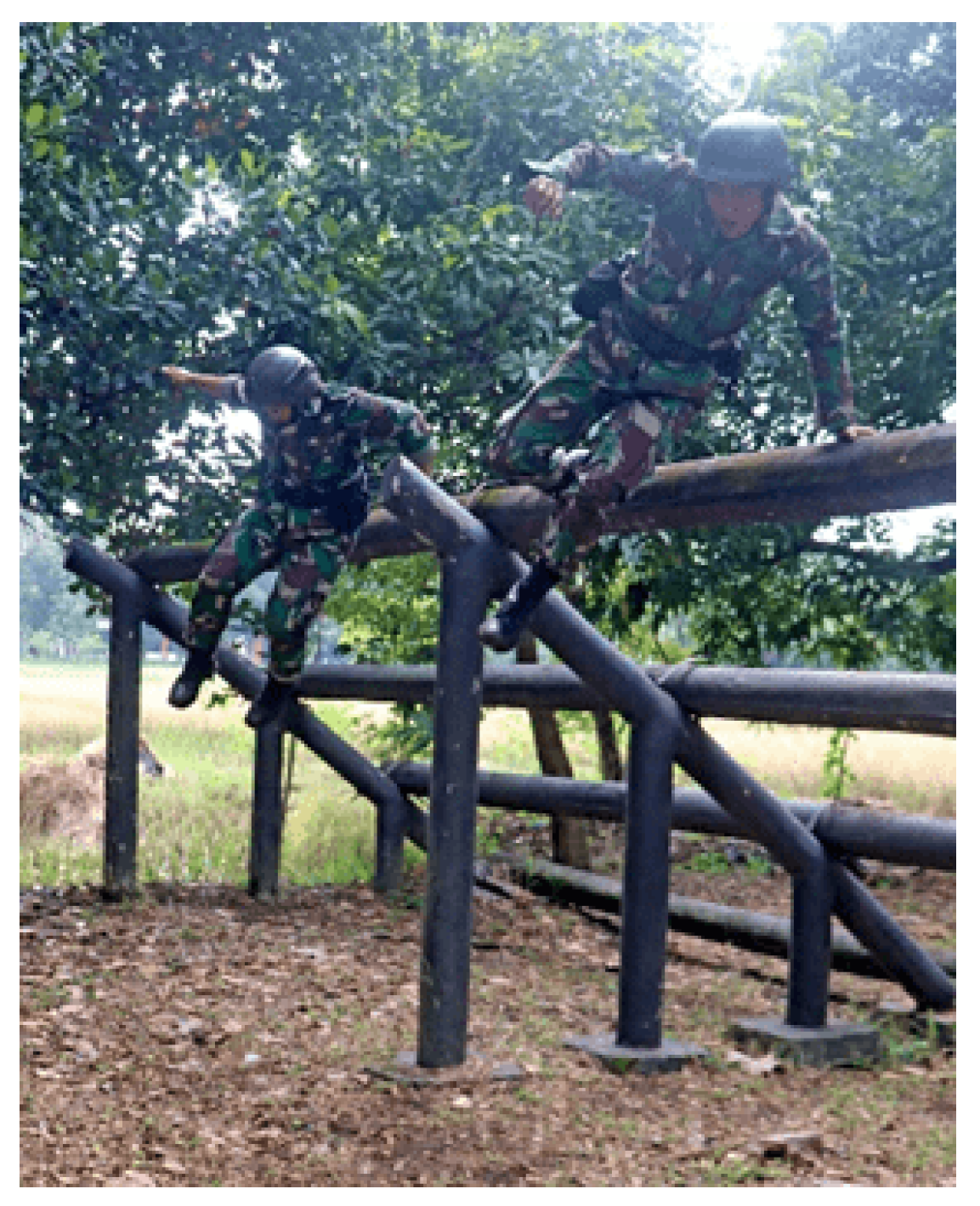
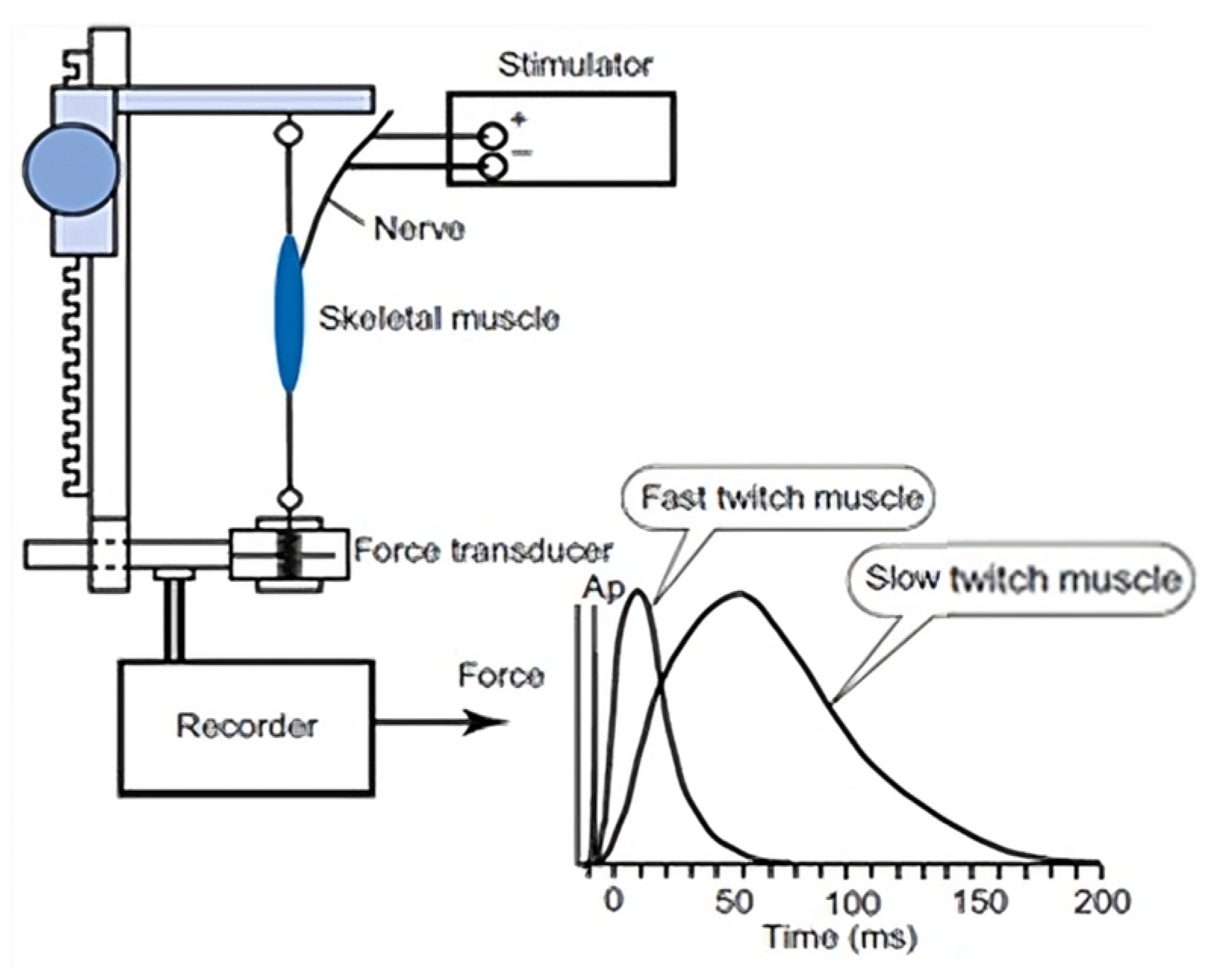
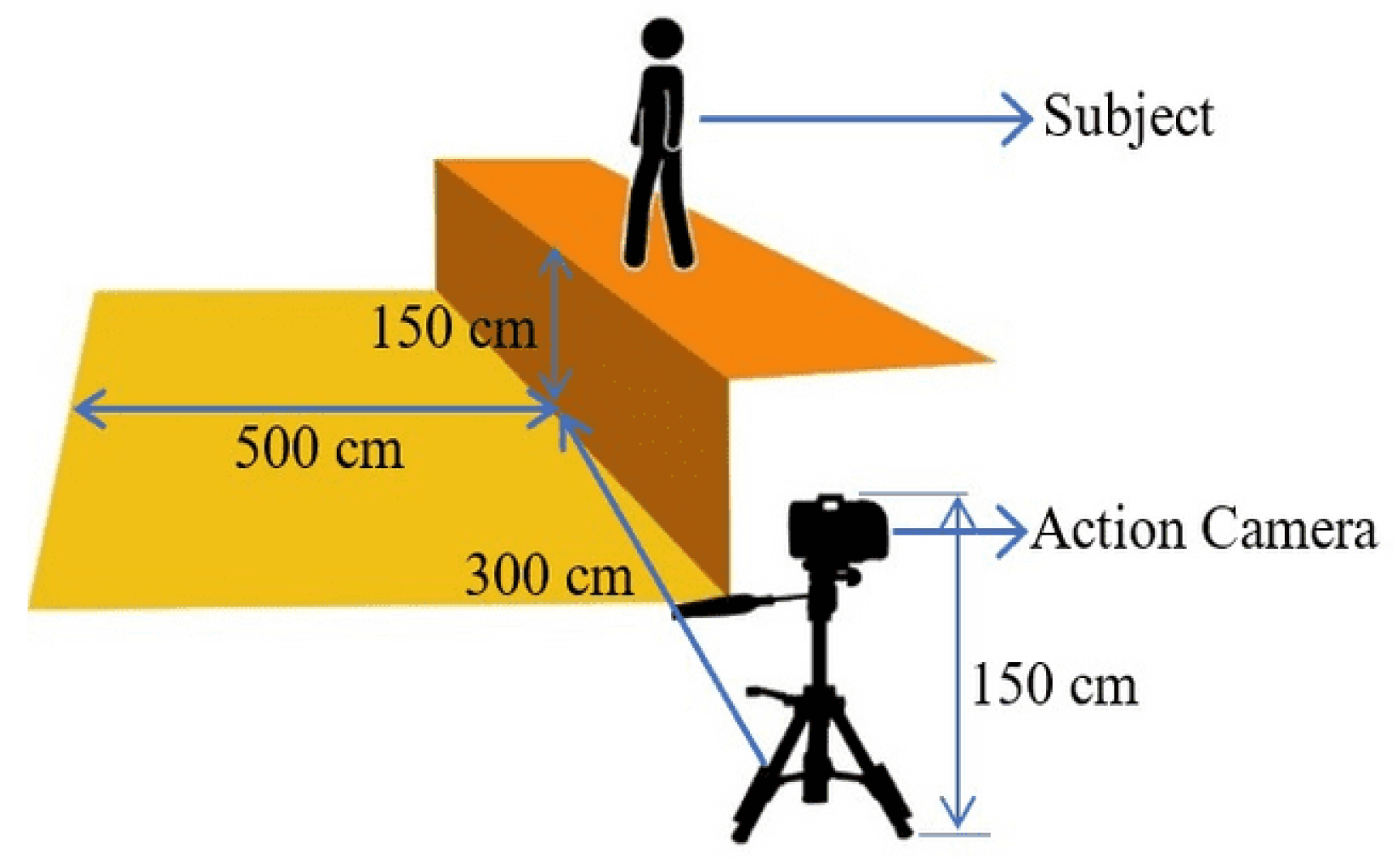
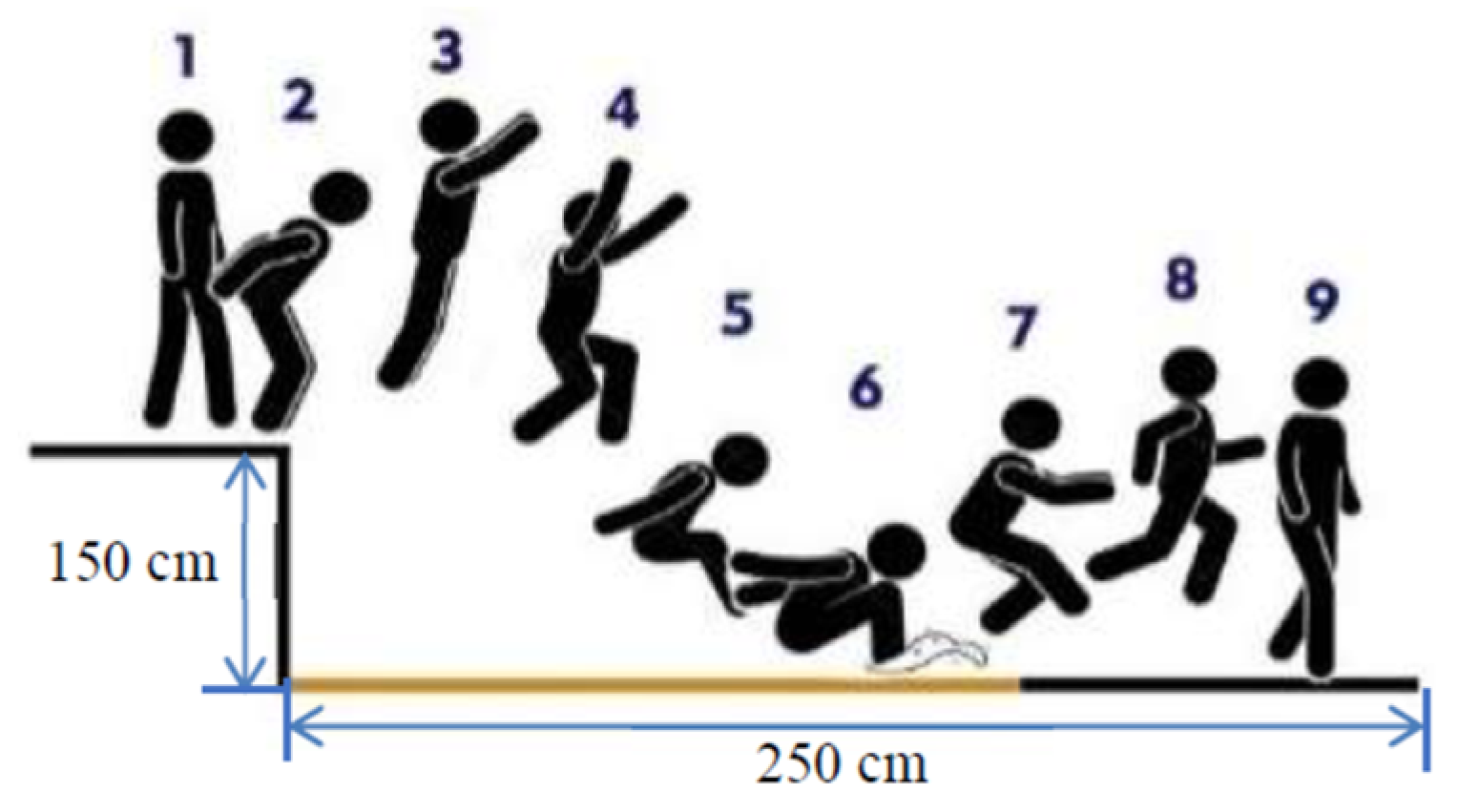
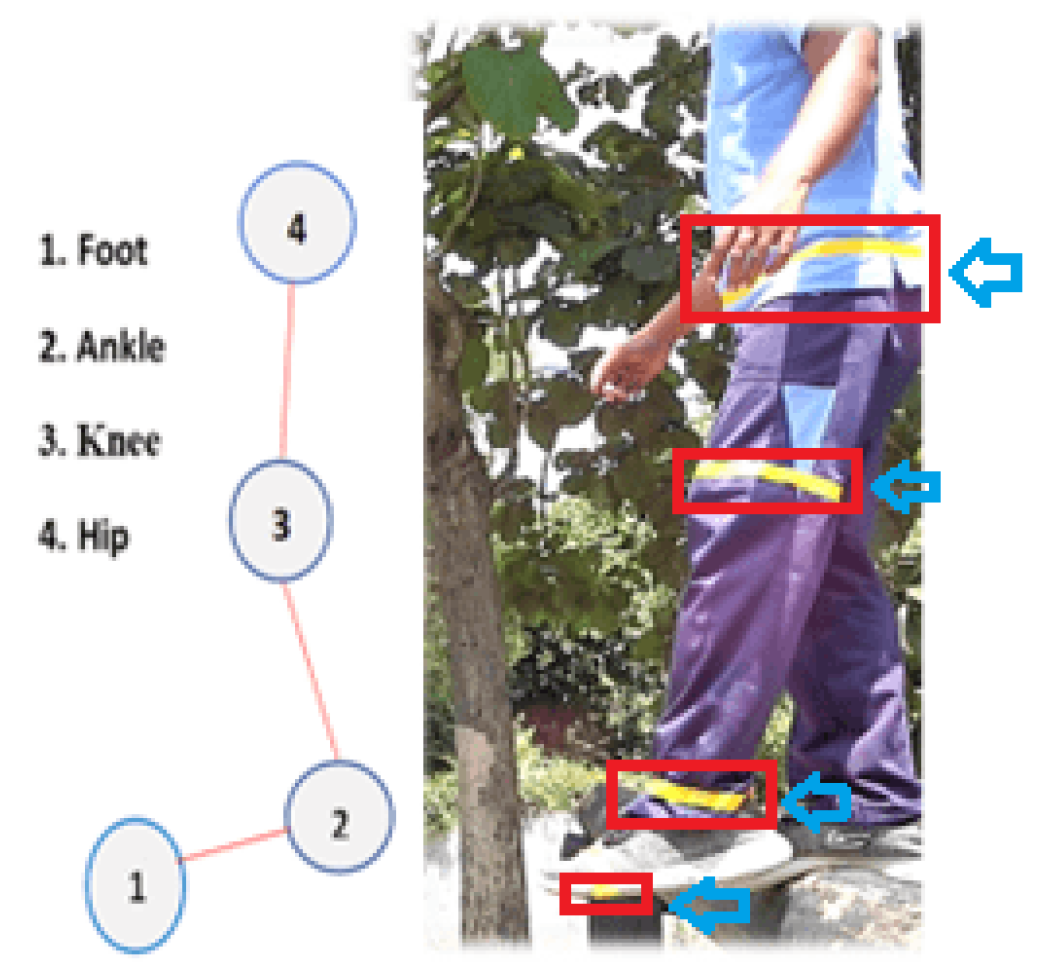
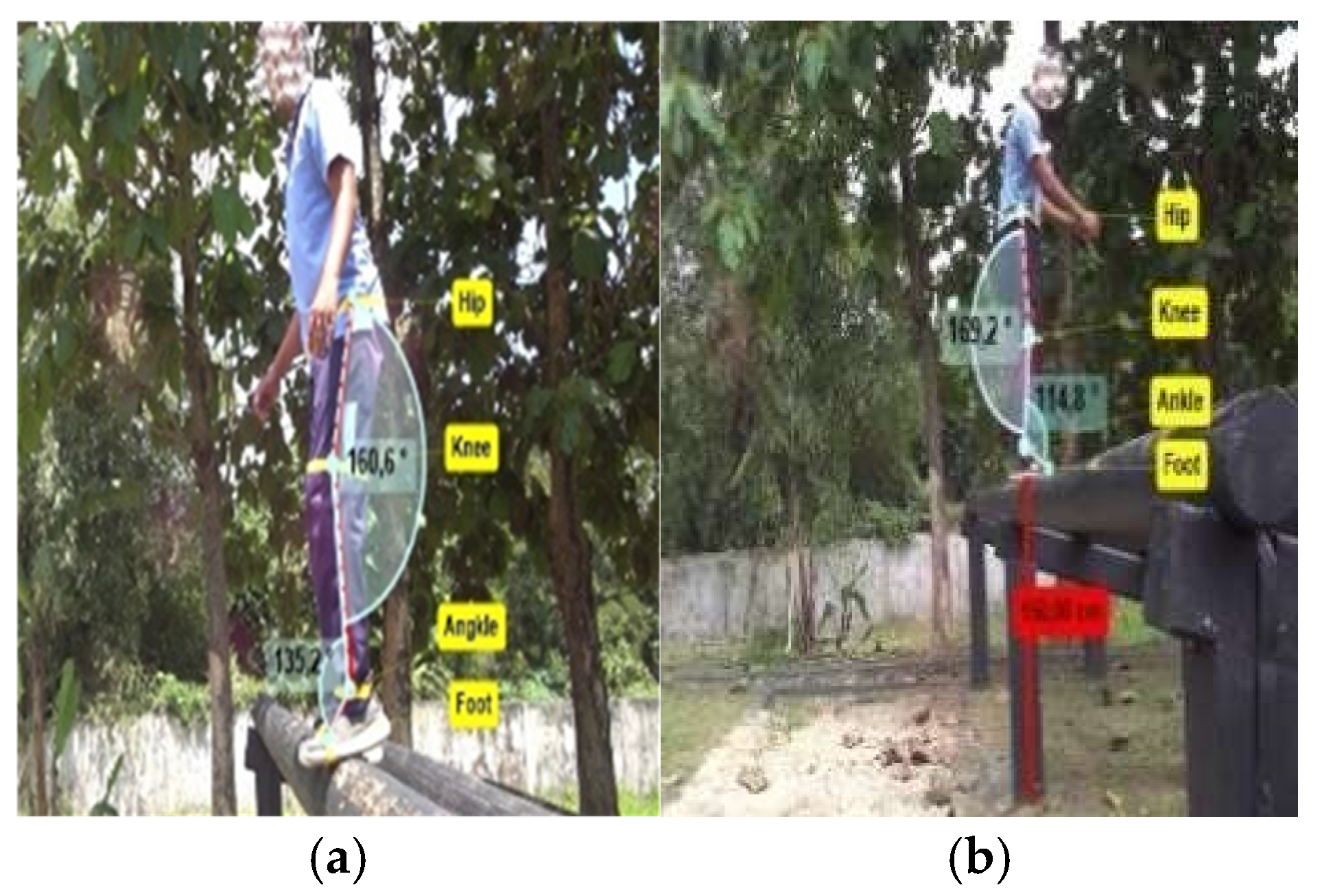
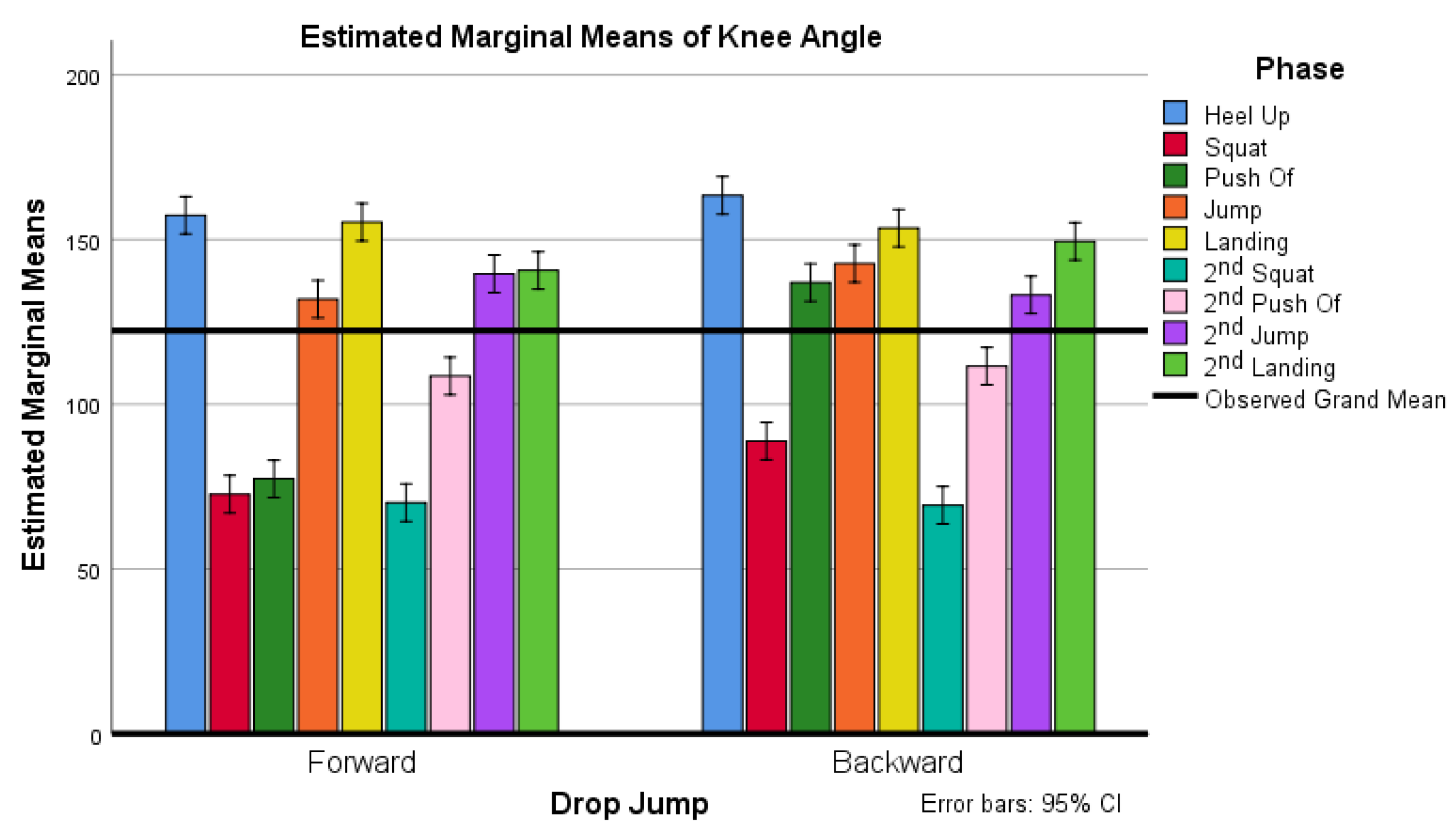
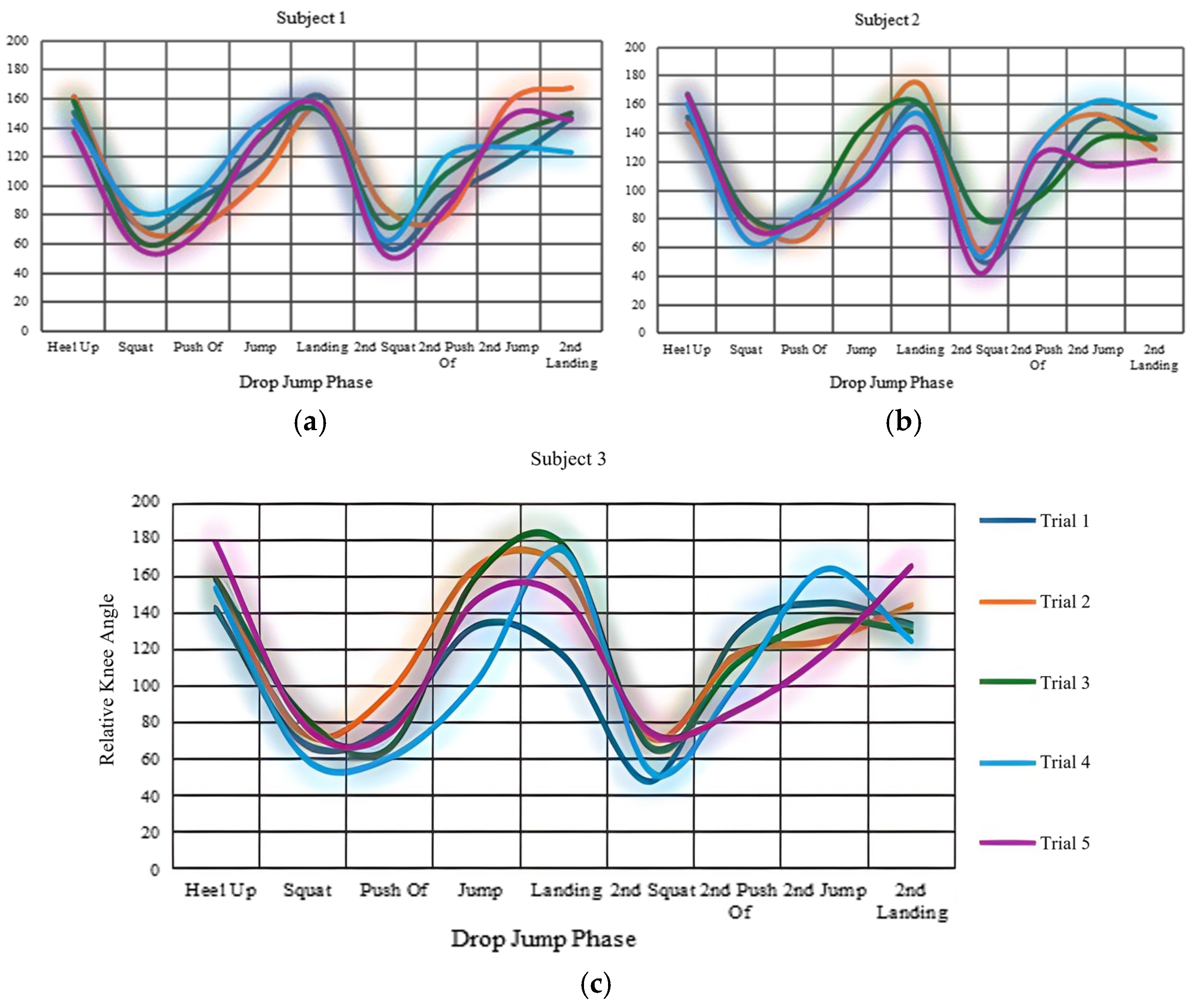
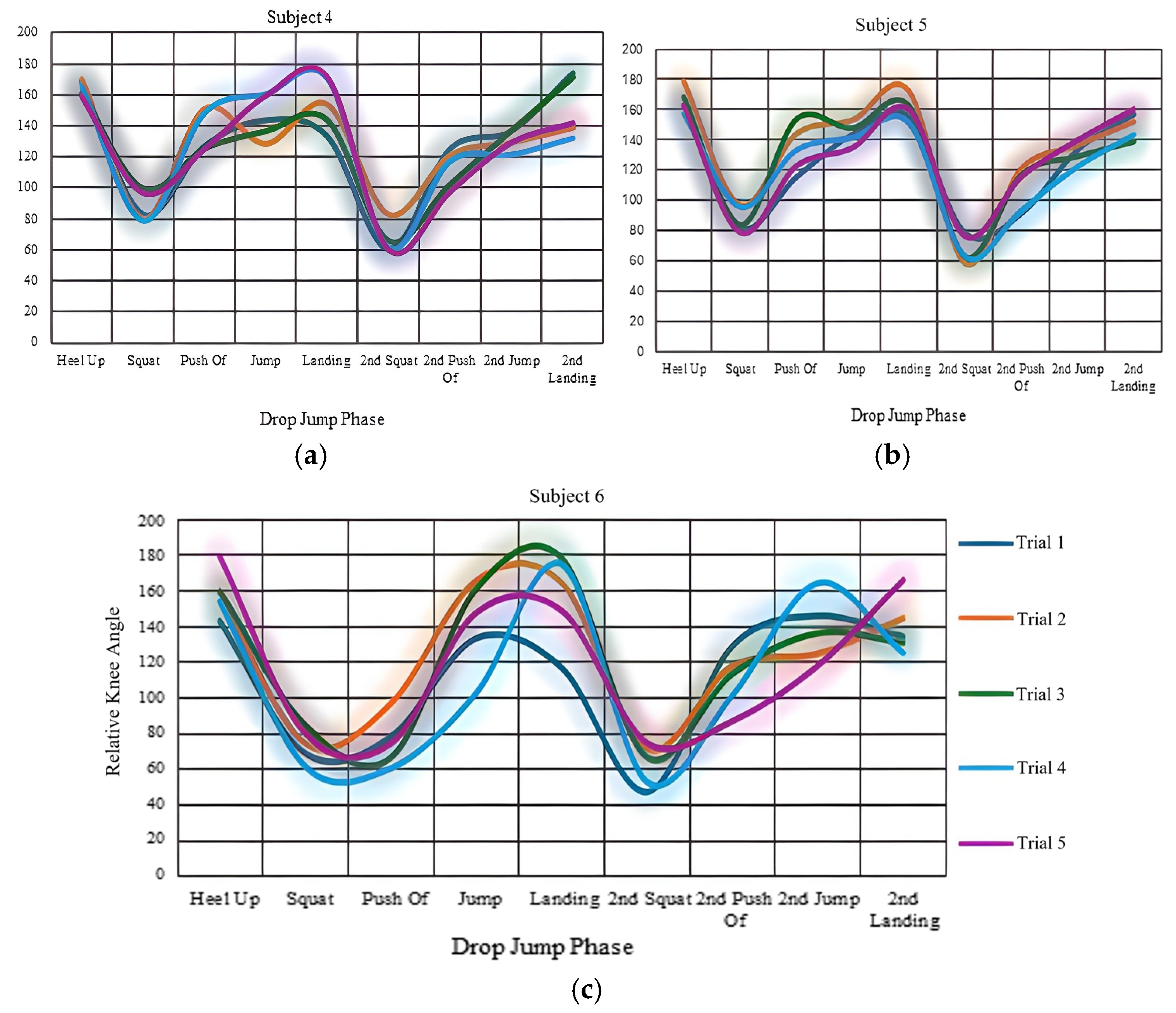
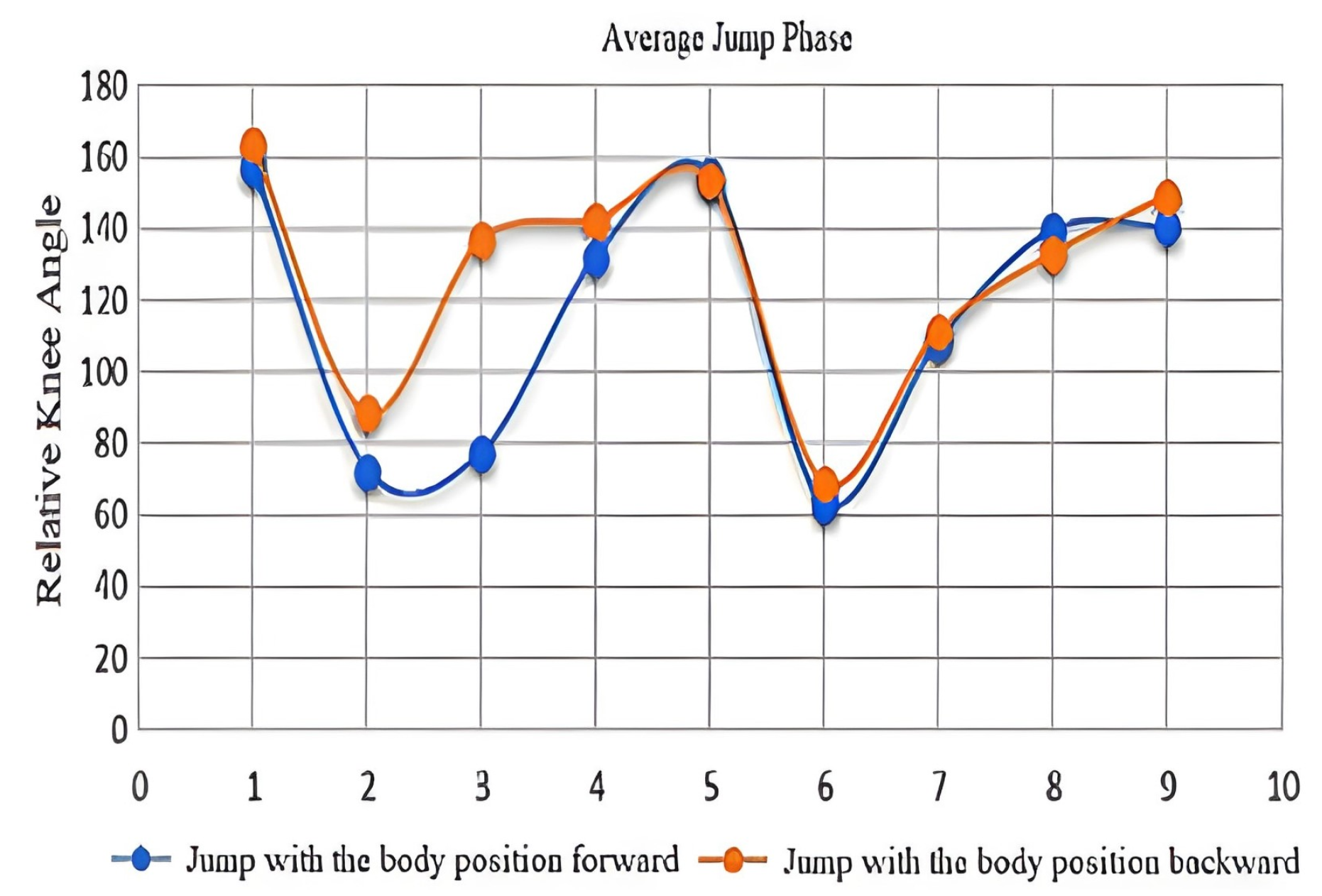
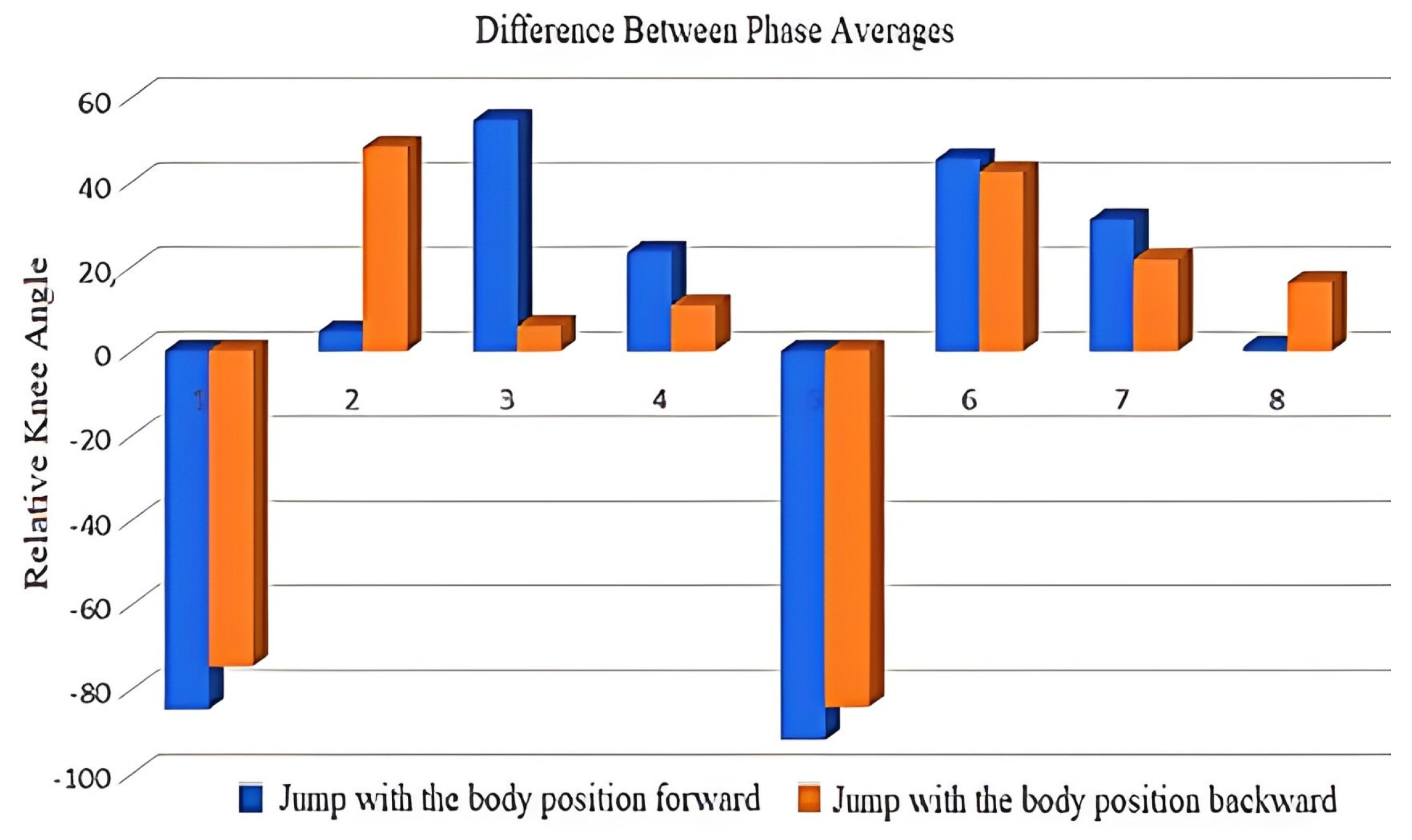
| Dependent Variable: Knee Angle | 95% Confidence Interval (Degree) | p-Value | ||||||
|---|---|---|---|---|---|---|---|---|
| Drop Jump | Phase | Muscle Contractions | Knee Angle (Mean ± SD) (Degree) | Lower Bound | Upper Bound | |||
| Forward Drop Jump | 1 | Heel Up | Isometric | 157.4 ± 11.1 | 117.04 ± 14.64 | 151.681 | 163.039 | 0.0001 |
| 2 | Squat | Isotonic | 72.7 ± 8.7 | 66.998 | 78.357 | |||
| 3 | Push Of | Isokinetic | 77.4 ± 11.3 | 71.684 | 83.042 | |||
| 4 | Jump | Isokinetic | 131.9 ± 19.8 | 126.209 | 137.568 | |||
| 5 | Landing | Isokinetic | 155.3 ± 15.0 | 149.571 | 160.930 | |||
| 6 | Second Squat | Isotonic | 70.1 ± 18.6 | 64.427 | 75.786 | |||
| 7 | Second Push Of | Isotonic | 108.6 ± 16.0 | 102.879 | 114.238 | |||
| 8 | Second Jump | Isotonic | 139.6 ± 16.7 | 133.884 | 145.243 | |||
| 9 | Second Landing | Isometric | 140.6 ± 14.6 | 134.946 | 146.304 | |||
| Backward Drop Jump | 1 | Heel Up | Isometric | 163.4 ± 8.0 | 127.65 ± 10.19 | 157.701 | 169.059 | 0.0001 |
| 2 | Squat | Isotonic | 88.8 ± 7.4 | 83.128 | 94.486 | |||
| 3 | Push Of | Isokinetic | 136.9 ± 12.1 | 131.255 | 142.613 | |||
| 4 | Jump | Isokinetic | 142.7 ± 9.9 | 137.037 | 148.396 | |||
| 5 | Landing | Isokinetic | 153.4 ± 12.8 | 147.765 | 159.124 | |||
| 6 | Second Squat | Isotonic | 69.4 ± 9.3 | 63.683 | 75.041 | |||
| 7 | Second Push Of | Isotonic | 111.6 ± 11.4 | 105.898 | 117.257 | |||
| 8 | Second Jump | Isotonic | 133.2 ± 8.8 | 127.487 | 138.846 | |||
| 9 | Second Landing | Isometric | 149.4 ± 12.0 | 143.759 | 155.118 | |||
Disclaimer/Publisher’s Note: The statements, opinions and data contained in all publications are solely those of the individual author(s) and contributor(s) and not of MDPI and/or the editor(s). MDPI and/or the editor(s) disclaim responsibility for any injury to people or property resulting from any ideas, methods, instructions or products referred to in the content. |
© 2025 by the authors. Licensee MDPI, Basel, Switzerland. This article is an open access article distributed under the terms and conditions of the Creative Commons Attribution (CC BY) license (https://creativecommons.org/licenses/by/4.0/).
Share and Cite
Herdiman, L.; Purnama, H.C. A Preliminary Study for Isometric, Isotonic, and Isokinetic Relationships in Vertical Drop Jumps at Heights on the Beam. Eng. Proc. 2025, 84, 78. https://doi.org/10.3390/engproc2025084078
Herdiman L, Purnama HC. A Preliminary Study for Isometric, Isotonic, and Isokinetic Relationships in Vertical Drop Jumps at Heights on the Beam. Engineering Proceedings. 2025; 84(1):78. https://doi.org/10.3390/engproc2025084078
Chicago/Turabian StyleHerdiman, Lobes, and Hendrawan Candra Purnama. 2025. "A Preliminary Study for Isometric, Isotonic, and Isokinetic Relationships in Vertical Drop Jumps at Heights on the Beam" Engineering Proceedings 84, no. 1: 78. https://doi.org/10.3390/engproc2025084078
APA StyleHerdiman, L., & Purnama, H. C. (2025). A Preliminary Study for Isometric, Isotonic, and Isokinetic Relationships in Vertical Drop Jumps at Heights on the Beam. Engineering Proceedings, 84(1), 78. https://doi.org/10.3390/engproc2025084078






